Finance in SMEs: A Comprehensive Analysis of Brompton Bicycle Ltd.
VerifiedAdded on 2021/02/20
|17
|4519
|62
Report
AI Summary
This report delves into the realm of finance within Small and Medium Enterprises (SMEs), utilizing Brompton Bicycle Ltd., a UK-based bicycle manufacturer, as a case study. The report meticulously explores various facets of SME finance, beginning with an examination of diverse sources of finance, including internal and external options like retained earnings, debentures, and loans. It then proceeds to a detailed ratio analysis, encompassing profitability, liquidity, and efficiency ratios to assess the financial performance of Brompton. The report further discusses investment appraisal techniques, particularly the Net Present Value (NPV) method, and explores different approaches to business valuation. Moreover, it addresses the significance of ethical values in decision-making within SMEs and concludes with a module learning log. The analysis provides a comprehensive overview of financial management in the context of SMEs, offering valuable insights into financial strategies and performance evaluation.

Finance in an SME
Paraphrase This Document
Need a fresh take? Get an instant paraphrase of this document with our AI Paraphraser
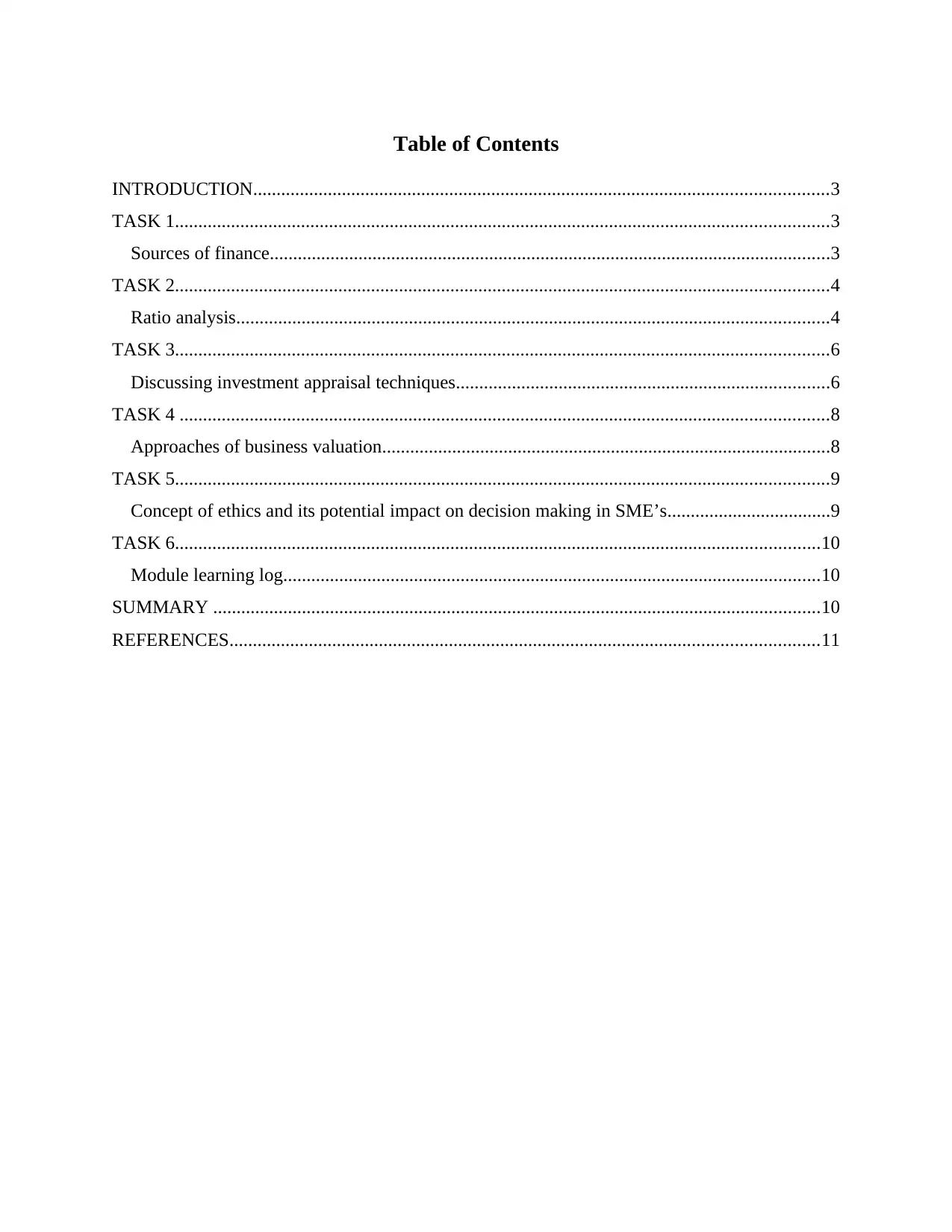
Table of Contents
INTRODUCTION...........................................................................................................................3
TASK 1............................................................................................................................................3
Sources of finance........................................................................................................................3
TASK 2............................................................................................................................................4
Ratio analysis...............................................................................................................................4
TASK 3............................................................................................................................................6
Discussing investment appraisal techniques................................................................................6
TASK 4 ...........................................................................................................................................8
Approaches of business valuation................................................................................................8
TASK 5............................................................................................................................................9
Concept of ethics and its potential impact on decision making in SME’s...................................9
TASK 6..........................................................................................................................................10
Module learning log...................................................................................................................10
SUMMARY ..................................................................................................................................10
REFERENCES..............................................................................................................................11
INTRODUCTION...........................................................................................................................3
TASK 1............................................................................................................................................3
Sources of finance........................................................................................................................3
TASK 2............................................................................................................................................4
Ratio analysis...............................................................................................................................4
TASK 3............................................................................................................................................6
Discussing investment appraisal techniques................................................................................6
TASK 4 ...........................................................................................................................................8
Approaches of business valuation................................................................................................8
TASK 5............................................................................................................................................9
Concept of ethics and its potential impact on decision making in SME’s...................................9
TASK 6..........................................................................................................................................10
Module learning log...................................................................................................................10
SUMMARY ..................................................................................................................................10
REFERENCES..............................................................................................................................11
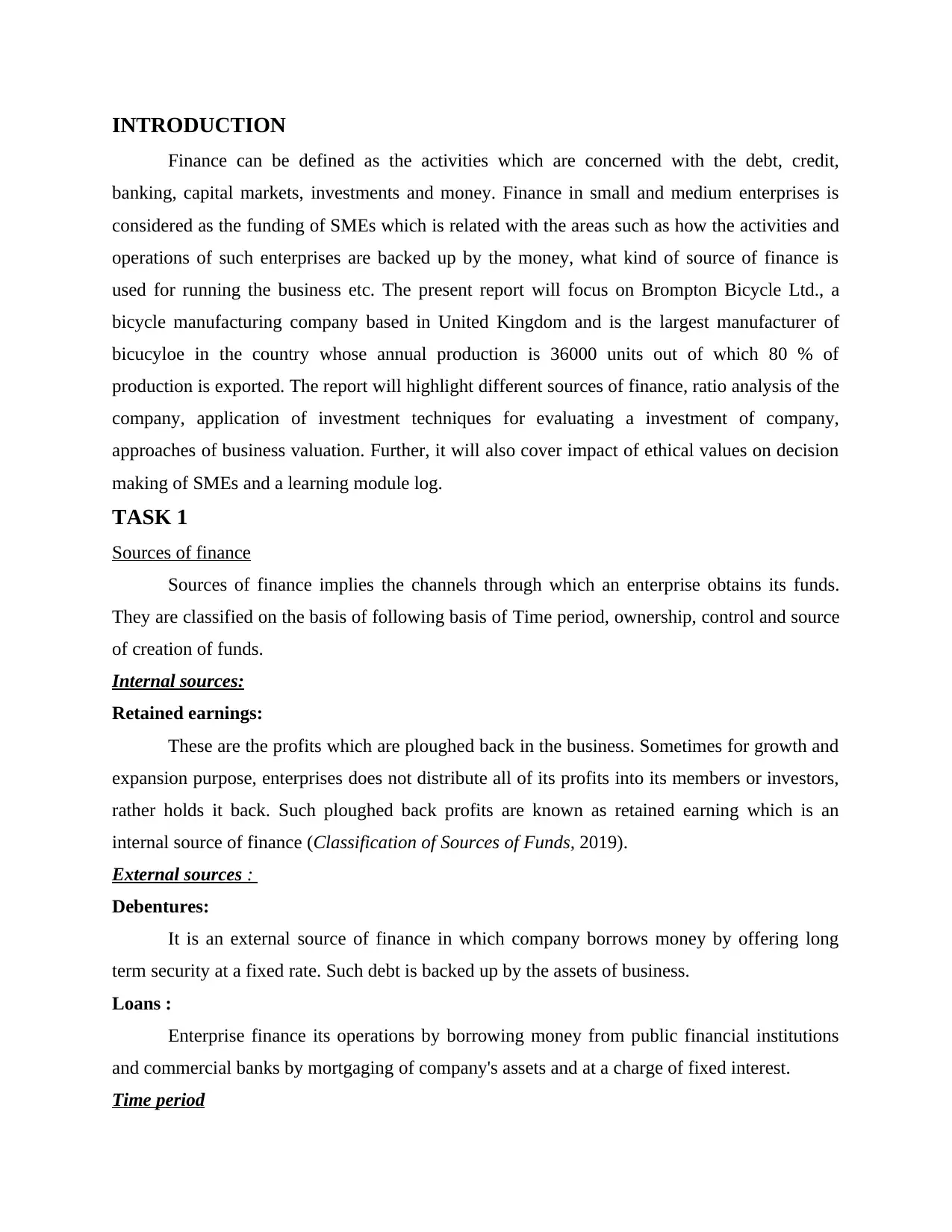
INTRODUCTION
Finance can be defined as the activities which are concerned with the debt, credit,
banking, capital markets, investments and money. Finance in small and medium enterprises is
considered as the funding of SMEs which is related with the areas such as how the activities and
operations of such enterprises are backed up by the money, what kind of source of finance is
used for running the business etc. The present report will focus on Brompton Bicycle Ltd., a
bicycle manufacturing company based in United Kingdom and is the largest manufacturer of
bicucyloe in the country whose annual production is 36000 units out of which 80 % of
production is exported. The report will highlight different sources of finance, ratio analysis of the
company, application of investment techniques for evaluating a investment of company,
approaches of business valuation. Further, it will also cover impact of ethical values on decision
making of SMEs and a learning module log.
TASK 1
Sources of finance
Sources of finance implies the channels through which an enterprise obtains its funds.
They are classified on the basis of following basis of Time period, ownership, control and source
of creation of funds.
Internal sources:
Retained earnings:
These are the profits which are ploughed back in the business. Sometimes for growth and
expansion purpose, enterprises does not distribute all of its profits into its members or investors,
rather holds it back. Such ploughed back profits are known as retained earning which is an
internal source of finance (Classification of Sources of Funds, 2019).
External sources :
Debentures:
It is an external source of finance in which company borrows money by offering long
term security at a fixed rate. Such debt is backed up by the assets of business.
Loans :
Enterprise finance its operations by borrowing money from public financial institutions
and commercial banks by mortgaging of company's assets and at a charge of fixed interest.
Time period
Finance can be defined as the activities which are concerned with the debt, credit,
banking, capital markets, investments and money. Finance in small and medium enterprises is
considered as the funding of SMEs which is related with the areas such as how the activities and
operations of such enterprises are backed up by the money, what kind of source of finance is
used for running the business etc. The present report will focus on Brompton Bicycle Ltd., a
bicycle manufacturing company based in United Kingdom and is the largest manufacturer of
bicucyloe in the country whose annual production is 36000 units out of which 80 % of
production is exported. The report will highlight different sources of finance, ratio analysis of the
company, application of investment techniques for evaluating a investment of company,
approaches of business valuation. Further, it will also cover impact of ethical values on decision
making of SMEs and a learning module log.
TASK 1
Sources of finance
Sources of finance implies the channels through which an enterprise obtains its funds.
They are classified on the basis of following basis of Time period, ownership, control and source
of creation of funds.
Internal sources:
Retained earnings:
These are the profits which are ploughed back in the business. Sometimes for growth and
expansion purpose, enterprises does not distribute all of its profits into its members or investors,
rather holds it back. Such ploughed back profits are known as retained earning which is an
internal source of finance (Classification of Sources of Funds, 2019).
External sources :
Debentures:
It is an external source of finance in which company borrows money by offering long
term security at a fixed rate. Such debt is backed up by the assets of business.
Loans :
Enterprise finance its operations by borrowing money from public financial institutions
and commercial banks by mortgaging of company's assets and at a charge of fixed interest.
Time period
⊘ This is a preview!⊘
Do you want full access?
Subscribe today to unlock all pages.

Trusted by 1+ million students worldwide
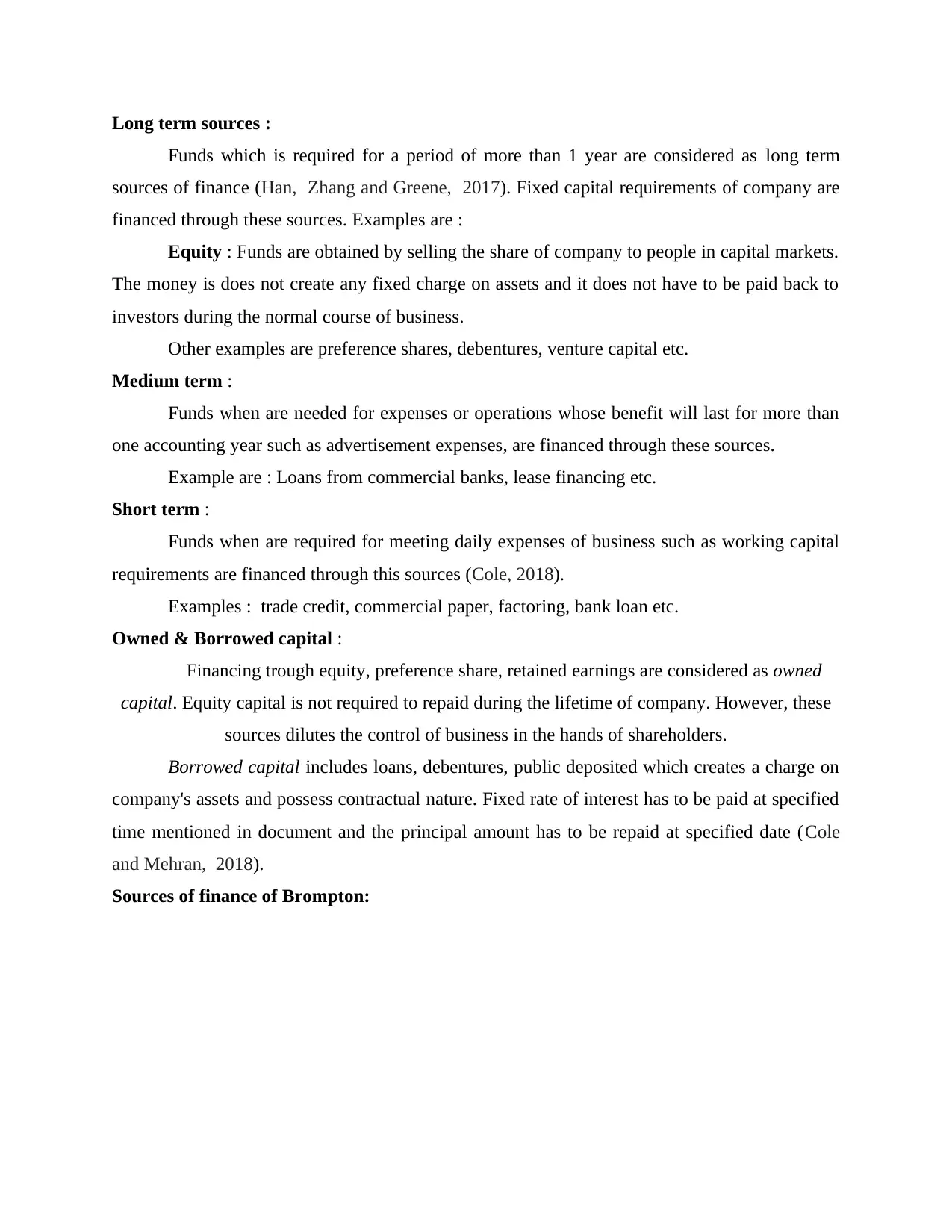
Long term sources :
Funds which is required for a period of more than 1 year are considered as long term
sources of finance (Han, Zhang and Greene, 2017). Fixed capital requirements of company are
financed through these sources. Examples are :
Equity : Funds are obtained by selling the share of company to people in capital markets.
The money is does not create any fixed charge on assets and it does not have to be paid back to
investors during the normal course of business.
Other examples are preference shares, debentures, venture capital etc.
Medium term :
Funds when are needed for expenses or operations whose benefit will last for more than
one accounting year such as advertisement expenses, are financed through these sources.
Example are : Loans from commercial banks, lease financing etc.
Short term :
Funds when are required for meeting daily expenses of business such as working capital
requirements are financed through this sources (Cole, 2018).
Examples : trade credit, commercial paper, factoring, bank loan etc.
Owned & Borrowed capital :
Financing trough equity, preference share, retained earnings are considered as owned
capital. Equity capital is not required to repaid during the lifetime of company. However, these
sources dilutes the control of business in the hands of shareholders.
Borrowed capital includes loans, debentures, public deposited which creates a charge on
company's assets and possess contractual nature. Fixed rate of interest has to be paid at specified
time mentioned in document and the principal amount has to be repaid at specified date (Cole
and Mehran, 2018).
Sources of finance of Brompton:
Funds which is required for a period of more than 1 year are considered as long term
sources of finance (Han, Zhang and Greene, 2017). Fixed capital requirements of company are
financed through these sources. Examples are :
Equity : Funds are obtained by selling the share of company to people in capital markets.
The money is does not create any fixed charge on assets and it does not have to be paid back to
investors during the normal course of business.
Other examples are preference shares, debentures, venture capital etc.
Medium term :
Funds when are needed for expenses or operations whose benefit will last for more than
one accounting year such as advertisement expenses, are financed through these sources.
Example are : Loans from commercial banks, lease financing etc.
Short term :
Funds when are required for meeting daily expenses of business such as working capital
requirements are financed through this sources (Cole, 2018).
Examples : trade credit, commercial paper, factoring, bank loan etc.
Owned & Borrowed capital :
Financing trough equity, preference share, retained earnings are considered as owned
capital. Equity capital is not required to repaid during the lifetime of company. However, these
sources dilutes the control of business in the hands of shareholders.
Borrowed capital includes loans, debentures, public deposited which creates a charge on
company's assets and possess contractual nature. Fixed rate of interest has to be paid at specified
time mentioned in document and the principal amount has to be repaid at specified date (Cole
and Mehran, 2018).
Sources of finance of Brompton:
Paraphrase This Document
Need a fresh take? Get an instant paraphrase of this document with our AI Paraphraser
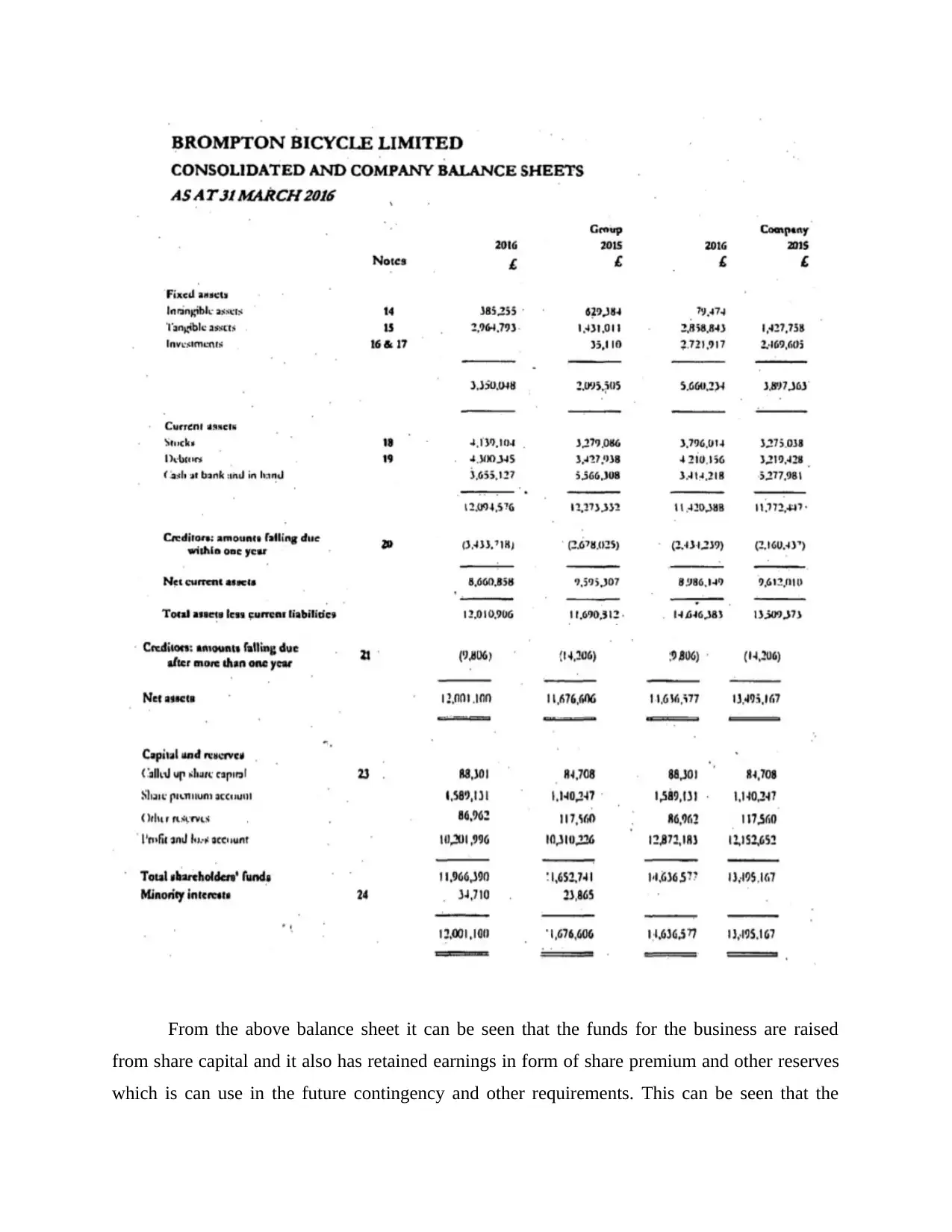
From the above balance sheet it can be seen that the funds for the business are raised
from share capital and it also has retained earnings in form of share premium and other reserves
which is can use in the future contingency and other requirements. This can be seen that the
from share capital and it also has retained earnings in form of share premium and other reserves
which is can use in the future contingency and other requirements. This can be seen that the
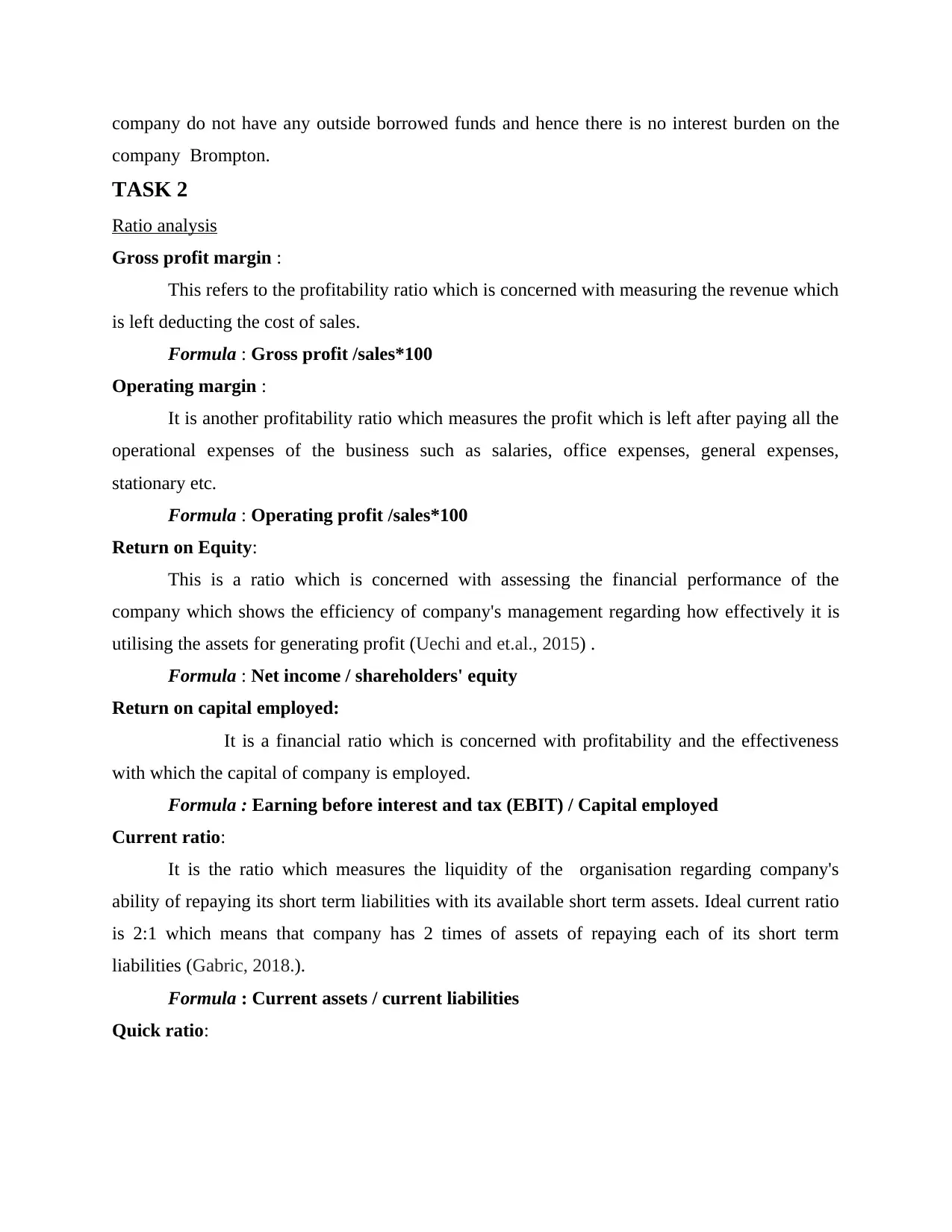
company do not have any outside borrowed funds and hence there is no interest burden on the
company Brompton.
TASK 2
Ratio analysis
Gross profit margin :
This refers to the profitability ratio which is concerned with measuring the revenue which
is left deducting the cost of sales.
Formula : Gross profit /sales*100
Operating margin :
It is another profitability ratio which measures the profit which is left after paying all the
operational expenses of the business such as salaries, office expenses, general expenses,
stationary etc.
Formula : Operating profit /sales*100
Return on Equity:
This is a ratio which is concerned with assessing the financial performance of the
company which shows the efficiency of company's management regarding how effectively it is
utilising the assets for generating profit (Uechi and et.al., 2015) .
Formula : Net income / shareholders' equity
Return on capital employed:
It is a financial ratio which is concerned with profitability and the effectiveness
with which the capital of company is employed.
Formula : Earning before interest and tax (EBIT) / Capital employed
Current ratio:
It is the ratio which measures the liquidity of the organisation regarding company's
ability of repaying its short term liabilities with its available short term assets. Ideal current ratio
is 2:1 which means that company has 2 times of assets of repaying each of its short term
liabilities (Gabric, 2018.).
Formula : Current assets / current liabilities
Quick ratio:
company Brompton.
TASK 2
Ratio analysis
Gross profit margin :
This refers to the profitability ratio which is concerned with measuring the revenue which
is left deducting the cost of sales.
Formula : Gross profit /sales*100
Operating margin :
It is another profitability ratio which measures the profit which is left after paying all the
operational expenses of the business such as salaries, office expenses, general expenses,
stationary etc.
Formula : Operating profit /sales*100
Return on Equity:
This is a ratio which is concerned with assessing the financial performance of the
company which shows the efficiency of company's management regarding how effectively it is
utilising the assets for generating profit (Uechi and et.al., 2015) .
Formula : Net income / shareholders' equity
Return on capital employed:
It is a financial ratio which is concerned with profitability and the effectiveness
with which the capital of company is employed.
Formula : Earning before interest and tax (EBIT) / Capital employed
Current ratio:
It is the ratio which measures the liquidity of the organisation regarding company's
ability of repaying its short term liabilities with its available short term assets. Ideal current ratio
is 2:1 which means that company has 2 times of assets of repaying each of its short term
liabilities (Gabric, 2018.).
Formula : Current assets / current liabilities
Quick ratio:
⊘ This is a preview!⊘
Do you want full access?
Subscribe today to unlock all pages.

Trusted by 1+ million students worldwide

It is one of the indicator of organisation's liquidity. It measures the capability of business
concern to repay its short term liabilities with its highly liquid assets. The ideal acid test ratio is
1:1.
Formula : Current assets- prepaid expenses- stock / current liabilities
Inventory turnover period:
This ratio measures the frequency of sales. It means number of times inventory has been
sold or consumed in a year.
Formula : Sales / average inventory
Debtors' collection period:
This refers to the length of duration for recovering the dues from debtors. Credit period is
allowed to customers for increasing the sales (Muritala, 2018).
Formula: Average debtors / net sales
Creditors payable period:
It is a financial ratio which is concerned with measuring the number of days which the
company takes for paying its liabilities – trade payables.
Formula : Average Accounts payable / COGS* Number of days
Gearing ratio:
This ratio measures the financial leverage of the company which assists in evaluating the
financial health of the organisation.
Formula : Long term debt + short term debt + bank overdrafts / shareholder's
equity
Interest coverage:
This ratio is related with measuring the ability of company to tackle its outstanding debt.
Market analysts says that a company cannot grow until it has the capability of paying interest on
its existing liabilities (Robinson and et.al., 2015).
Formula : EBIT / Interest expense
Ratio analysis
Ratios 2015 2016 change
Profitability ratios
Gross profit
margin
10.29/27.48
=0 .37 11.26/28.42
=.39
0.02
concern to repay its short term liabilities with its highly liquid assets. The ideal acid test ratio is
1:1.
Formula : Current assets- prepaid expenses- stock / current liabilities
Inventory turnover period:
This ratio measures the frequency of sales. It means number of times inventory has been
sold or consumed in a year.
Formula : Sales / average inventory
Debtors' collection period:
This refers to the length of duration for recovering the dues from debtors. Credit period is
allowed to customers for increasing the sales (Muritala, 2018).
Formula: Average debtors / net sales
Creditors payable period:
It is a financial ratio which is concerned with measuring the number of days which the
company takes for paying its liabilities – trade payables.
Formula : Average Accounts payable / COGS* Number of days
Gearing ratio:
This ratio measures the financial leverage of the company which assists in evaluating the
financial health of the organisation.
Formula : Long term debt + short term debt + bank overdrafts / shareholder's
equity
Interest coverage:
This ratio is related with measuring the ability of company to tackle its outstanding debt.
Market analysts says that a company cannot grow until it has the capability of paying interest on
its existing liabilities (Robinson and et.al., 2015).
Formula : EBIT / Interest expense
Ratio analysis
Ratios 2015 2016 change
Profitability ratios
Gross profit
margin
10.29/27.48
=0 .37 11.26/28.42
=.39
0.02
Paraphrase This Document
Need a fresh take? Get an instant paraphrase of this document with our AI Paraphraser
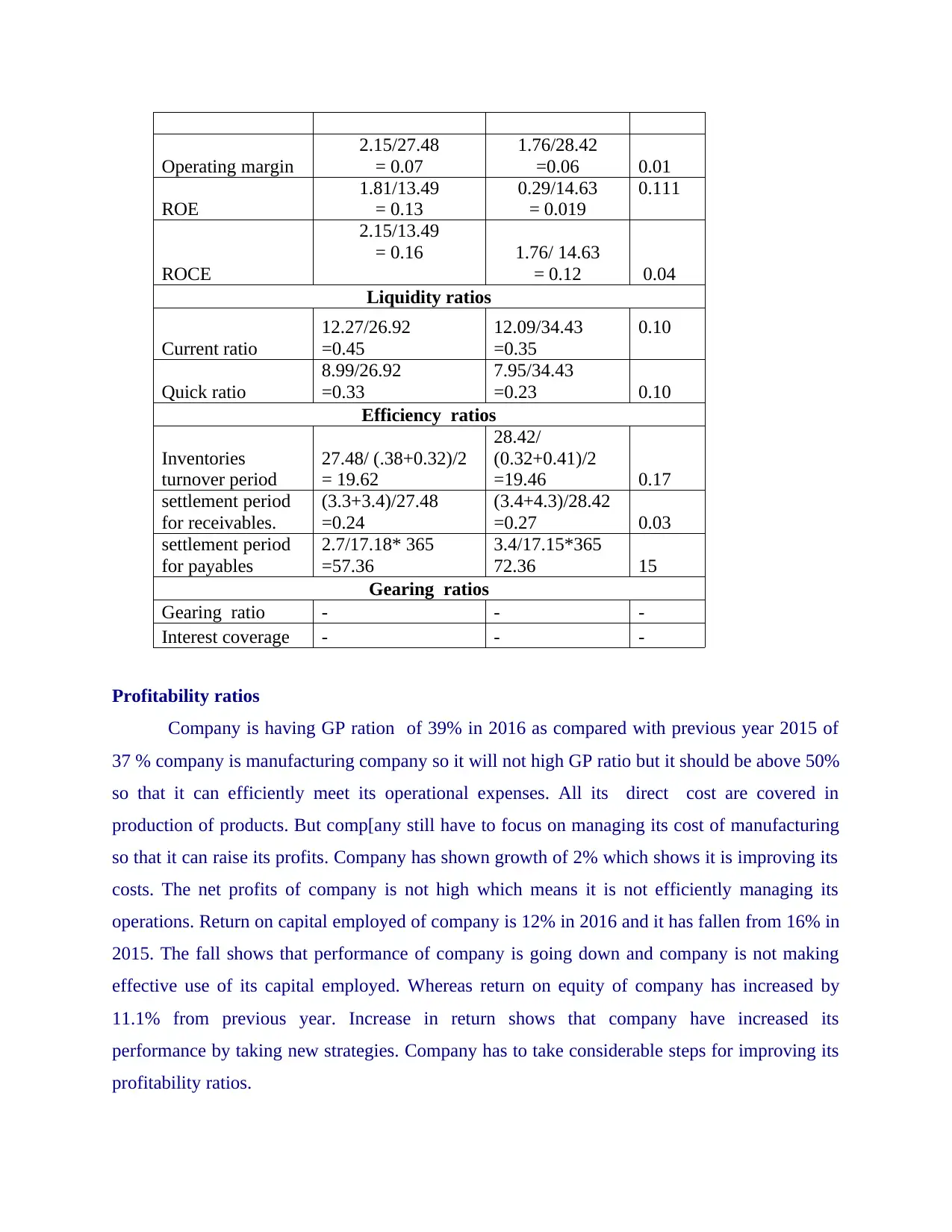
Operating margin
2.15/27.48
= 0.07
1.76/28.42
=0.06 0.01
ROE
1.81/13.49
= 0.13
0.29/14.63
= 0.019
0.111
ROCE
2.15/13.49
= 0.16 1.76/ 14.63
= 0.12 0.04
Liquidity ratios
Current ratio
12.27/26.92
=0.45
12.09/34.43
=0.35
0.10
Quick ratio
8.99/26.92
=0.33
7.95/34.43
=0.23 0.10
Efficiency ratios
Inventories
turnover period
27.48/ (.38+0.32)/2
= 19.62
28.42/
(0.32+0.41)/2
=19.46 0.17
settlement period
for receivables.
(3.3+3.4)/27.48
=0.24
(3.4+4.3)/28.42
=0.27 0.03
settlement period
for payables
2.7/17.18* 365
=57.36
3.4/17.15*365
72.36 15
Gearing ratios
Gearing ratio - - -
Interest coverage - - -
Profitability ratios
Company is having GP ration of 39% in 2016 as compared with previous year 2015 of
37 % company is manufacturing company so it will not high GP ratio but it should be above 50%
so that it can efficiently meet its operational expenses. All its direct cost are covered in
production of products. But comp[any still have to focus on managing its cost of manufacturing
so that it can raise its profits. Company has shown growth of 2% which shows it is improving its
costs. The net profits of company is not high which means it is not efficiently managing its
operations. Return on capital employed of company is 12% in 2016 and it has fallen from 16% in
2015. The fall shows that performance of company is going down and company is not making
effective use of its capital employed. Whereas return on equity of company has increased by
11.1% from previous year. Increase in return shows that company have increased its
performance by taking new strategies. Company has to take considerable steps for improving its
profitability ratios.
2.15/27.48
= 0.07
1.76/28.42
=0.06 0.01
ROE
1.81/13.49
= 0.13
0.29/14.63
= 0.019
0.111
ROCE
2.15/13.49
= 0.16 1.76/ 14.63
= 0.12 0.04
Liquidity ratios
Current ratio
12.27/26.92
=0.45
12.09/34.43
=0.35
0.10
Quick ratio
8.99/26.92
=0.33
7.95/34.43
=0.23 0.10
Efficiency ratios
Inventories
turnover period
27.48/ (.38+0.32)/2
= 19.62
28.42/
(0.32+0.41)/2
=19.46 0.17
settlement period
for receivables.
(3.3+3.4)/27.48
=0.24
(3.4+4.3)/28.42
=0.27 0.03
settlement period
for payables
2.7/17.18* 365
=57.36
3.4/17.15*365
72.36 15
Gearing ratios
Gearing ratio - - -
Interest coverage - - -
Profitability ratios
Company is having GP ration of 39% in 2016 as compared with previous year 2015 of
37 % company is manufacturing company so it will not high GP ratio but it should be above 50%
so that it can efficiently meet its operational expenses. All its direct cost are covered in
production of products. But comp[any still have to focus on managing its cost of manufacturing
so that it can raise its profits. Company has shown growth of 2% which shows it is improving its
costs. The net profits of company is not high which means it is not efficiently managing its
operations. Return on capital employed of company is 12% in 2016 and it has fallen from 16% in
2015. The fall shows that performance of company is going down and company is not making
effective use of its capital employed. Whereas return on equity of company has increased by
11.1% from previous year. Increase in return shows that company have increased its
performance by taking new strategies. Company has to take considerable steps for improving its
profitability ratios.

Liquidity ratios
Liquidity ratios of company shows that it is not having strong liquidity position. Standard
current ratio is 2:1 whereas it has ratio of 0.35 in 2016. the current assets of company are not
sufficient to meet its current liabilities. The rise may be because the companies are not having
pending collection for its sales. Quick ratio is 0.23 as against standard of 1:1 which shows that
even after excluding inventory its liquidity is not rising. Ratios shows that company's liquidity
position of has gone down from previous year. Company is not able to raise its liquidity.
Company has to implement new plans so that its liquidity is increased. It is important for
company to improve its liquidity position otherwise it may affect operations of company.
Efficiency ratios
From above efficiency ratios it can be identified that inventory ratio for 2015 is 19.62 and
for 2016 it is 19.46. from the inventory ratio it can be figured out that company is having good
cash flows for running its operations. Settlement period of receivables have increased which
shows that company is becoming flexible in its cash collections. Company have to stop at this
level as rising above this level may affect cash flows of company. Settlement period of payables
has gone high in 2016 from 2015 by 15 points. High settlement period shows that company is
having problems to meet its debt over short time. High ratio will give time to utilise the money
over other operations for raising returns.
The above table depict the changes in the various ratios of the company Brompton for
two consecutive years, 2015 and 2016 and the variance or changes in the ratios of two years. For
the profitability ratios no major changes can be seen means the profitability level of company
cannot change from 2015 to 2016. A shift of 10% in both current and quick ratio can be seen
which means the liquidity position of the company is not good at all. The company do not have
any outside debts so there is no interest burden on the business.
TASK 3
Discussing investment appraisal techniques
Investments needs to be evaluated and analysed in terms of benefits its is going to
provide is worthy enough or not. Following are the investment appraisal techniques :
Net present value method (NPV):
The profitability of a project or investment is assessed by ascertaining the variation
between cash inflows that will generated by investment in future and initial cash outflow.
Liquidity ratios of company shows that it is not having strong liquidity position. Standard
current ratio is 2:1 whereas it has ratio of 0.35 in 2016. the current assets of company are not
sufficient to meet its current liabilities. The rise may be because the companies are not having
pending collection for its sales. Quick ratio is 0.23 as against standard of 1:1 which shows that
even after excluding inventory its liquidity is not rising. Ratios shows that company's liquidity
position of has gone down from previous year. Company is not able to raise its liquidity.
Company has to implement new plans so that its liquidity is increased. It is important for
company to improve its liquidity position otherwise it may affect operations of company.
Efficiency ratios
From above efficiency ratios it can be identified that inventory ratio for 2015 is 19.62 and
for 2016 it is 19.46. from the inventory ratio it can be figured out that company is having good
cash flows for running its operations. Settlement period of receivables have increased which
shows that company is becoming flexible in its cash collections. Company have to stop at this
level as rising above this level may affect cash flows of company. Settlement period of payables
has gone high in 2016 from 2015 by 15 points. High settlement period shows that company is
having problems to meet its debt over short time. High ratio will give time to utilise the money
over other operations for raising returns.
The above table depict the changes in the various ratios of the company Brompton for
two consecutive years, 2015 and 2016 and the variance or changes in the ratios of two years. For
the profitability ratios no major changes can be seen means the profitability level of company
cannot change from 2015 to 2016. A shift of 10% in both current and quick ratio can be seen
which means the liquidity position of the company is not good at all. The company do not have
any outside debts so there is no interest burden on the business.
TASK 3
Discussing investment appraisal techniques
Investments needs to be evaluated and analysed in terms of benefits its is going to
provide is worthy enough or not. Following are the investment appraisal techniques :
Net present value method (NPV):
The profitability of a project or investment is assessed by ascertaining the variation
between cash inflows that will generated by investment in future and initial cash outflow.
⊘ This is a preview!⊘
Do you want full access?
Subscribe today to unlock all pages.

Trusted by 1+ million students worldwide
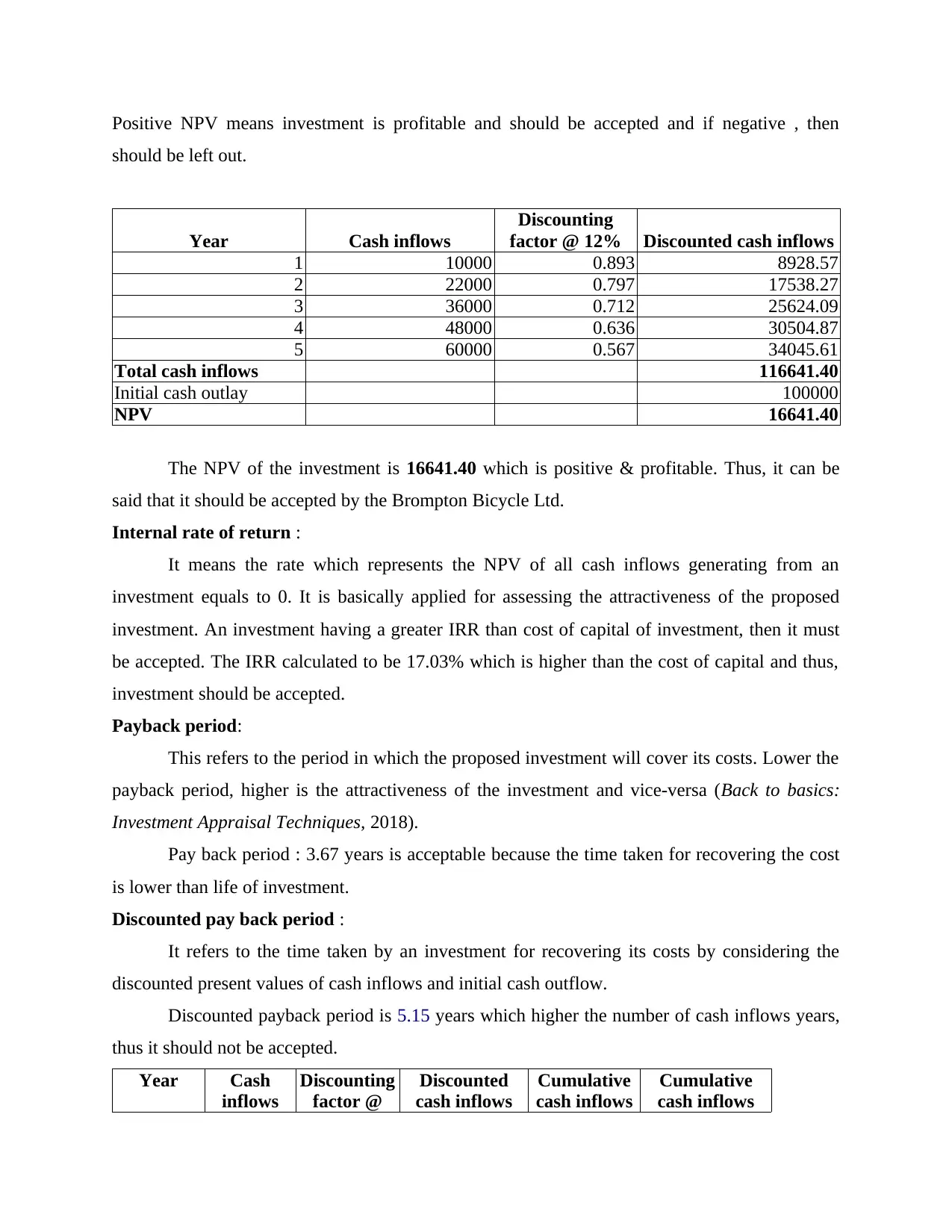
Positive NPV means investment is profitable and should be accepted and if negative , then
should be left out.
Year Cash inflows
Discounting
factor @ 12% Discounted cash inflows
1 10000 0.893 8928.57
2 22000 0.797 17538.27
3 36000 0.712 25624.09
4 48000 0.636 30504.87
5 60000 0.567 34045.61
Total cash inflows 116641.40
Initial cash outlay 100000
NPV 16641.40
The NPV of the investment is 16641.40 which is positive & profitable. Thus, it can be
said that it should be accepted by the Brompton Bicycle Ltd.
Internal rate of return :
It means the rate which represents the NPV of all cash inflows generating from an
investment equals to 0. It is basically applied for assessing the attractiveness of the proposed
investment. An investment having a greater IRR than cost of capital of investment, then it must
be accepted. The IRR calculated to be 17.03% which is higher than the cost of capital and thus,
investment should be accepted.
Payback period:
This refers to the period in which the proposed investment will cover its costs. Lower the
payback period, higher is the attractiveness of the investment and vice-versa (Back to basics:
Investment Appraisal Techniques, 2018).
Pay back period : 3.67 years is acceptable because the time taken for recovering the cost
is lower than life of investment.
Discounted pay back period :
It refers to the time taken by an investment for recovering its costs by considering the
discounted present values of cash inflows and initial cash outflow.
Discounted payback period is 5.15 years which higher the number of cash inflows years,
thus it should not be accepted.
Year Cash
inflows
Discounting
factor @
Discounted
cash inflows
Cumulative
cash inflows
Cumulative
cash inflows
should be left out.
Year Cash inflows
Discounting
factor @ 12% Discounted cash inflows
1 10000 0.893 8928.57
2 22000 0.797 17538.27
3 36000 0.712 25624.09
4 48000 0.636 30504.87
5 60000 0.567 34045.61
Total cash inflows 116641.40
Initial cash outlay 100000
NPV 16641.40
The NPV of the investment is 16641.40 which is positive & profitable. Thus, it can be
said that it should be accepted by the Brompton Bicycle Ltd.
Internal rate of return :
It means the rate which represents the NPV of all cash inflows generating from an
investment equals to 0. It is basically applied for assessing the attractiveness of the proposed
investment. An investment having a greater IRR than cost of capital of investment, then it must
be accepted. The IRR calculated to be 17.03% which is higher than the cost of capital and thus,
investment should be accepted.
Payback period:
This refers to the period in which the proposed investment will cover its costs. Lower the
payback period, higher is the attractiveness of the investment and vice-versa (Back to basics:
Investment Appraisal Techniques, 2018).
Pay back period : 3.67 years is acceptable because the time taken for recovering the cost
is lower than life of investment.
Discounted pay back period :
It refers to the time taken by an investment for recovering its costs by considering the
discounted present values of cash inflows and initial cash outflow.
Discounted payback period is 5.15 years which higher the number of cash inflows years,
thus it should not be accepted.
Year Cash
inflows
Discounting
factor @
Discounted
cash inflows
Cumulative
cash inflows
Cumulative
cash inflows
Paraphrase This Document
Need a fresh take? Get an instant paraphrase of this document with our AI Paraphraser
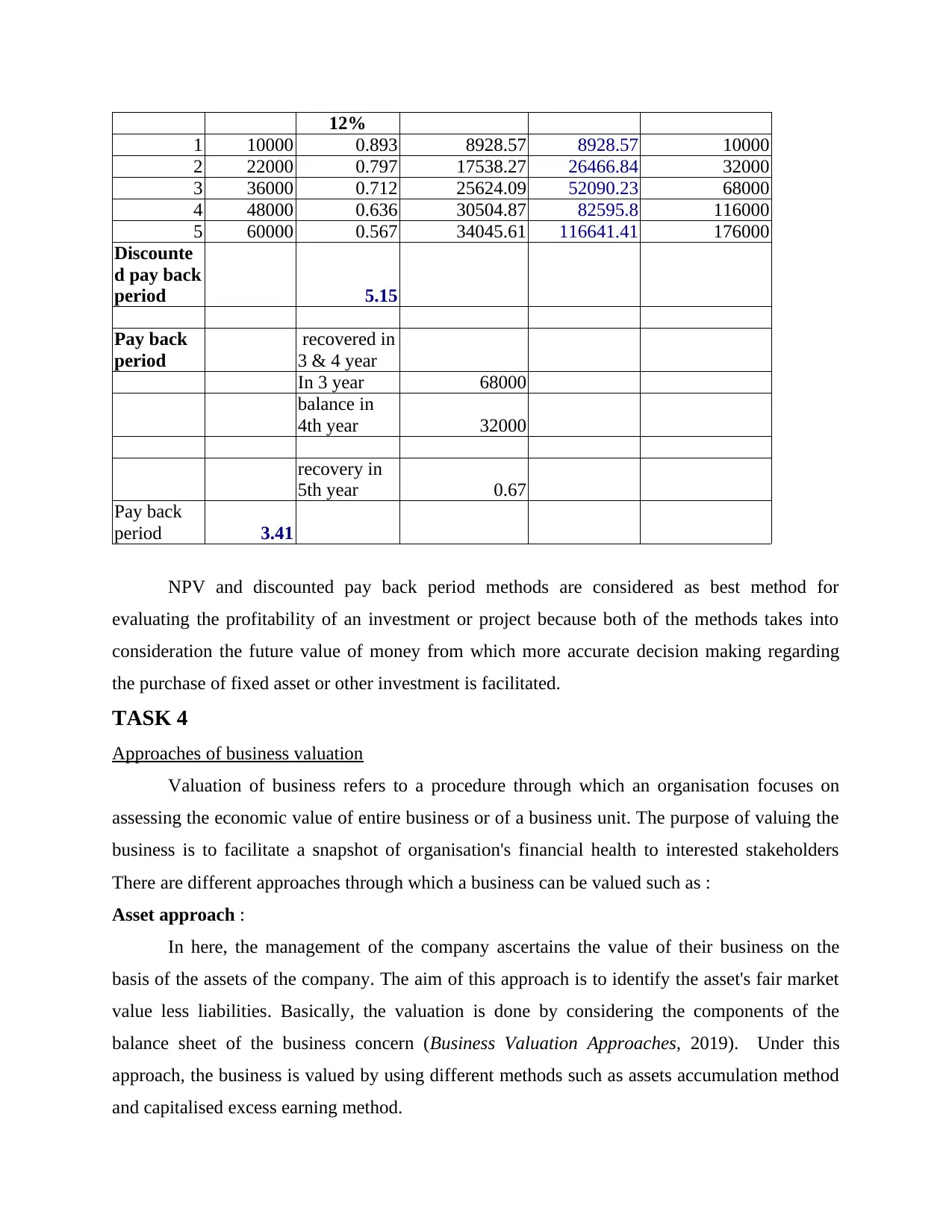
12%
1 10000 0.893 8928.57 8928.57 10000
2 22000 0.797 17538.27 26466.84 32000
3 36000 0.712 25624.09 52090.23 68000
4 48000 0.636 30504.87 82595.8 116000
5 60000 0.567 34045.61 116641.41 176000
Discounte
d pay back
period 5.15
Pay back
period
recovered in
3 & 4 year
In 3 year 68000
balance in
4th year 32000
recovery in
5th year 0.67
Pay back
period 3.41
NPV and discounted pay back period methods are considered as best method for
evaluating the profitability of an investment or project because both of the methods takes into
consideration the future value of money from which more accurate decision making regarding
the purchase of fixed asset or other investment is facilitated.
TASK 4
Approaches of business valuation
Valuation of business refers to a procedure through which an organisation focuses on
assessing the economic value of entire business or of a business unit. The purpose of valuing the
business is to facilitate a snapshot of organisation's financial health to interested stakeholders
There are different approaches through which a business can be valued such as :
Asset approach :
In here, the management of the company ascertains the value of their business on the
basis of the assets of the company. The aim of this approach is to identify the asset's fair market
value less liabilities. Basically, the valuation is done by considering the components of the
balance sheet of the business concern (Business Valuation Approaches, 2019). Under this
approach, the business is valued by using different methods such as assets accumulation method
and capitalised excess earning method.
1 10000 0.893 8928.57 8928.57 10000
2 22000 0.797 17538.27 26466.84 32000
3 36000 0.712 25624.09 52090.23 68000
4 48000 0.636 30504.87 82595.8 116000
5 60000 0.567 34045.61 116641.41 176000
Discounte
d pay back
period 5.15
Pay back
period
recovered in
3 & 4 year
In 3 year 68000
balance in
4th year 32000
recovery in
5th year 0.67
Pay back
period 3.41
NPV and discounted pay back period methods are considered as best method for
evaluating the profitability of an investment or project because both of the methods takes into
consideration the future value of money from which more accurate decision making regarding
the purchase of fixed asset or other investment is facilitated.
TASK 4
Approaches of business valuation
Valuation of business refers to a procedure through which an organisation focuses on
assessing the economic value of entire business or of a business unit. The purpose of valuing the
business is to facilitate a snapshot of organisation's financial health to interested stakeholders
There are different approaches through which a business can be valued such as :
Asset approach :
In here, the management of the company ascertains the value of their business on the
basis of the assets of the company. The aim of this approach is to identify the asset's fair market
value less liabilities. Basically, the valuation is done by considering the components of the
balance sheet of the business concern (Business Valuation Approaches, 2019). Under this
approach, the business is valued by using different methods such as assets accumulation method
and capitalised excess earning method.

For example, through asset accumulation method, company can determine the value of
its assets as it is the increase in the assets of financial nature through savings, investments or
earnings. It can be measured as the change in the value of investments in monetary terms,
amount which is reinvested or the change in the assets' value owned by the company.
Market approach :
In this approach, management focus on determining the value of business by comparing
the historic sales of similar businesses in the industry. Real market conditions are used for
figuring the worth of the business of an organisation. In this approach company uses
transactional data for determining the value of the company. The method includes the
transactions of public, private companies along with the measures of valuation of public
companies by using market data relating to current stock (Bowe and Van der Horst, 2016).
For example, in the business of Brampton, the management can value its business by
looking at the bases for comparisons such as sales of bicycles of similar business enterprise in
terms of size and nature located within UK.
Income approach :
Under this approach, the business is valued on the basis of the capability of company's to
yield the desired economic result for its owners. The main objective of this approach is to
ascertain the business value as a function of economic outcomes. Discounted cash flow and cap
rates are its methods which the manager uses for assessing the worth of the business.
TASK 5
Concept of ethics and its potential impact on decision making in SME’s
Ethics is a terms which signifies the beliefs or values which differentiates between right
or wrong about a phenomenon or a thing. Conducting business operation within the framework
of corporate governance and ethics aids Brompton in establishing and creating a good working
conditions. Basic ethics which the enterprises must have are integrity and trust. Business ethics
involves all the obligations which the SMEs have towards customers, employees, suppliers,
neighbours and even competitors.
Ethics greatly impacts the decision making of SMEs. For example, people desires to
work for the organisation which is high on its ethical practises. This way, ethics plays great role
in Brompton in deciding the policies and procedures relating recruiting & selection. Because
reputation of brand plays a great role in the success of the SMEs, the top management has started
its assets as it is the increase in the assets of financial nature through savings, investments or
earnings. It can be measured as the change in the value of investments in monetary terms,
amount which is reinvested or the change in the assets' value owned by the company.
Market approach :
In this approach, management focus on determining the value of business by comparing
the historic sales of similar businesses in the industry. Real market conditions are used for
figuring the worth of the business of an organisation. In this approach company uses
transactional data for determining the value of the company. The method includes the
transactions of public, private companies along with the measures of valuation of public
companies by using market data relating to current stock (Bowe and Van der Horst, 2016).
For example, in the business of Brampton, the management can value its business by
looking at the bases for comparisons such as sales of bicycles of similar business enterprise in
terms of size and nature located within UK.
Income approach :
Under this approach, the business is valued on the basis of the capability of company's to
yield the desired economic result for its owners. The main objective of this approach is to
ascertain the business value as a function of economic outcomes. Discounted cash flow and cap
rates are its methods which the manager uses for assessing the worth of the business.
TASK 5
Concept of ethics and its potential impact on decision making in SME’s
Ethics is a terms which signifies the beliefs or values which differentiates between right
or wrong about a phenomenon or a thing. Conducting business operation within the framework
of corporate governance and ethics aids Brompton in establishing and creating a good working
conditions. Basic ethics which the enterprises must have are integrity and trust. Business ethics
involves all the obligations which the SMEs have towards customers, employees, suppliers,
neighbours and even competitors.
Ethics greatly impacts the decision making of SMEs. For example, people desires to
work for the organisation which is high on its ethical practises. This way, ethics plays great role
in Brompton in deciding the policies and procedures relating recruiting & selection. Because
reputation of brand plays a great role in the success of the SMEs, the top management has started
⊘ This is a preview!⊘
Do you want full access?
Subscribe today to unlock all pages.

Trusted by 1+ million students worldwide
1 out of 17
Related Documents
Your All-in-One AI-Powered Toolkit for Academic Success.
+13062052269
info@desklib.com
Available 24*7 on WhatsApp / Email
![[object Object]](/_next/static/media/star-bottom.7253800d.svg)
Unlock your academic potential
Copyright © 2020–2025 A2Z Services. All Rights Reserved. Developed and managed by ZUCOL.





